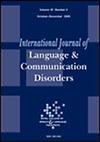Perspectives on goal setting: Video-reflexive ethnography with speech–language therapists and clients
Abstract
Background
Goal setting is an essential step in the clinical reasoning process of speech and language therapists (SLTs) who provide care for children, adolescents and adults with communication disorders. In the light of person-centred care, shared or collaborative goal setting between the SLT and client is advised in (inter)national guidelines. SLTs face challenges in implementing (shared) goal setting as theoretical frameworks and practical interventions are scarce and less applicable to use with a wide range of communication vulnerable populations.
Aims
A first step in developing theory and practical interventions is to explore first-hand experiences of SLTs and clients about day-to-day goal-setting practice. This study was guided by the following research question: What are the perspectives and needs of SLTs and persons with communication disorders regarding (shared) goal setting in routine SLT services?
Methods & Procedures
The qualitative study was carried out in the setting of routine speech–language therapy services in community practices, primary education and neurological rehabilitation in the Netherlands. Data collection followed the principles of video-reflexive ethnography, using video footage of goal-setting conversations to facilitate semi-structured, reflexive interviews. Data analysis was based on reflexive thematic analysis. A total of 12 interviews were conducted with client–SLT dyads, covering perspectives from children, parents and adults with a range of communication difficulties and their SLTs.
Outcomes & Results
Data analysis resulted in four themes, of which two contain subthemes. Each theme represents a central organizing concept found in SLT and client interviews. The themes were identified as: (1) goal setting is a complex process; (2) goal talk needs to be communication accessible; (3) communicative participation goals are hard to grasp; and (4) the importance of relationships. Topics such as power imbalance, communication vulnerability, effective communication strategies, and motivation and trust are explored under these themes.
Conclusions & Implications
SLTs are encouraged to view shared goal setting as a process that needs to be explicitly planned and communicated with clients regardless of their age or communication vulnerability. SLTs have expert knowledge and skills when it comes to supporting communication and applying these skills during goal talks might strengthen shared goal setting and foster a therapeutic relationship. There is a need to concretely conceptualize and embed shared goal setting in policy and clinical guidelines. The themes reported have tentative clinical implications for developing such policy, and shared goal-setting interventions for SLT practice, under the condition that SLTs and people with communication disorders are continuously involved.
WHAT THIS PAPER ADDS
What is already known on the subject
- SLTs want to set meaningful goals together with their patients but lack theory and resources to effectively shape the goal-setting process. Few studies have directly reported on the perspectives and needs of SLTs and patients regarding goal setting. Patients generally perceive goal setting as a vague activity in which they minimally participate. SLTs want to involve patients in the goal-setting process and describe the potential benefits, but they also want to report barriers on the systemic and professional competence level.
What this paper adds to the existing knowledge
- SLTs and patients perceive shared goal setting as a multifaceted process, rather than a one-off conversation. This process holds potential vulnerabilities for SLTs and patients alike, and the themes in this study propose potentially helpful ingredients to mediate this vulnerability and shape the goal-setting process.
What are the potential or clinical implications of this work?
- To take the first steps towards effective shared goal setting, SLTs should embrace the element of discovery in goal setting and apply their expert knowledge in supporting communication. To develop practical interventions for SLTs, shared goal setting needs to be further conceptualized and embedded in policy and clinical guidelines.

 求助内容:
求助内容: 应助结果提醒方式:
应助结果提醒方式:


